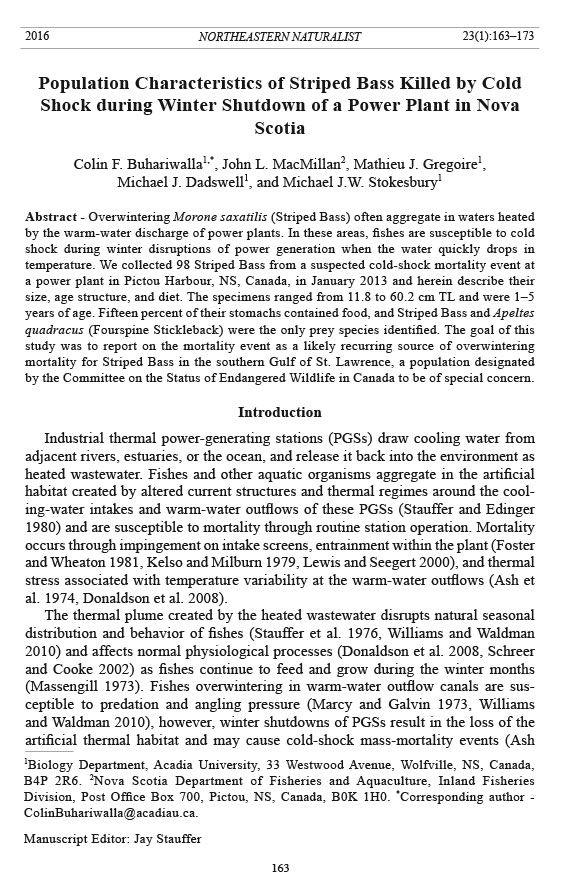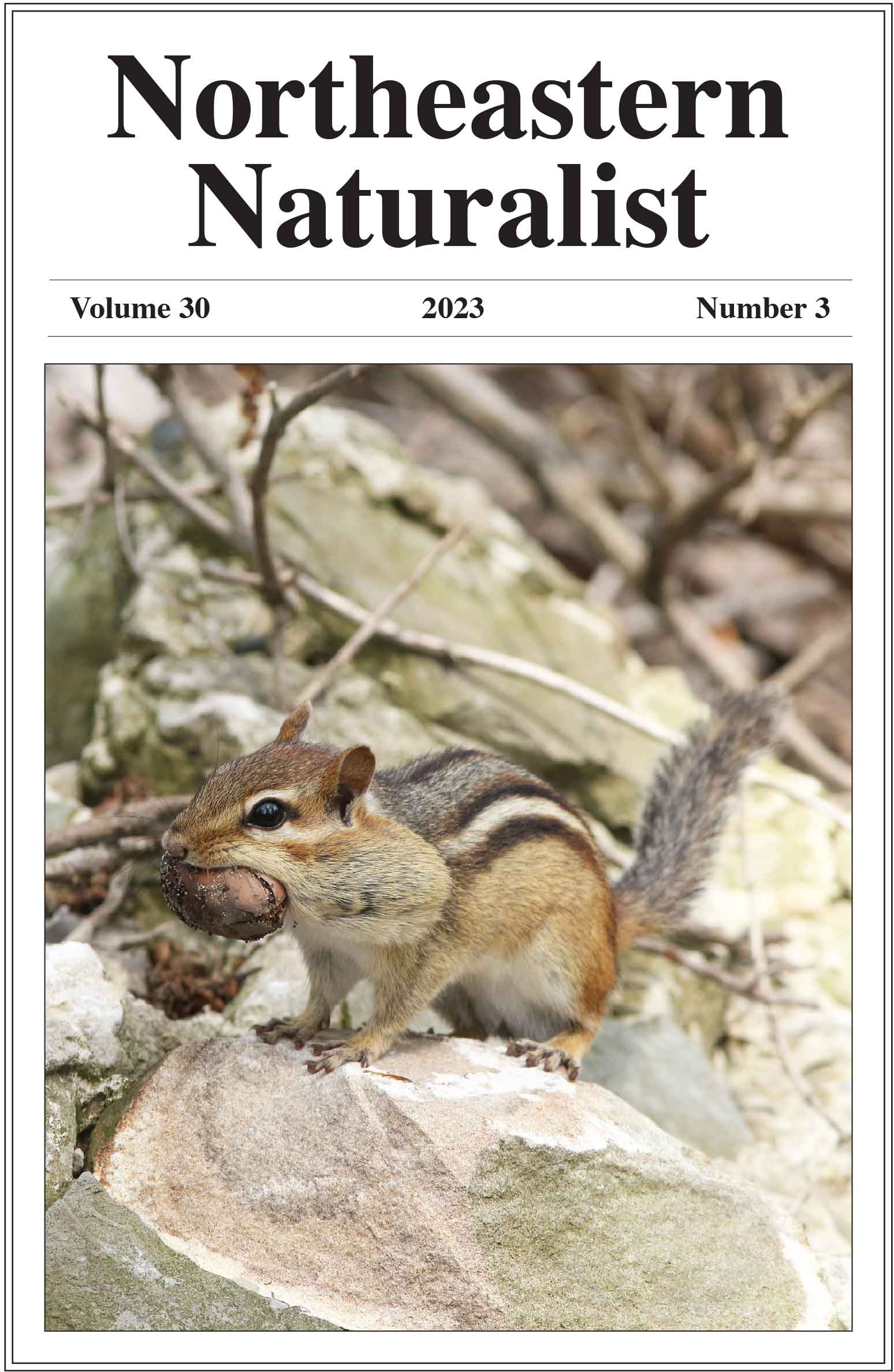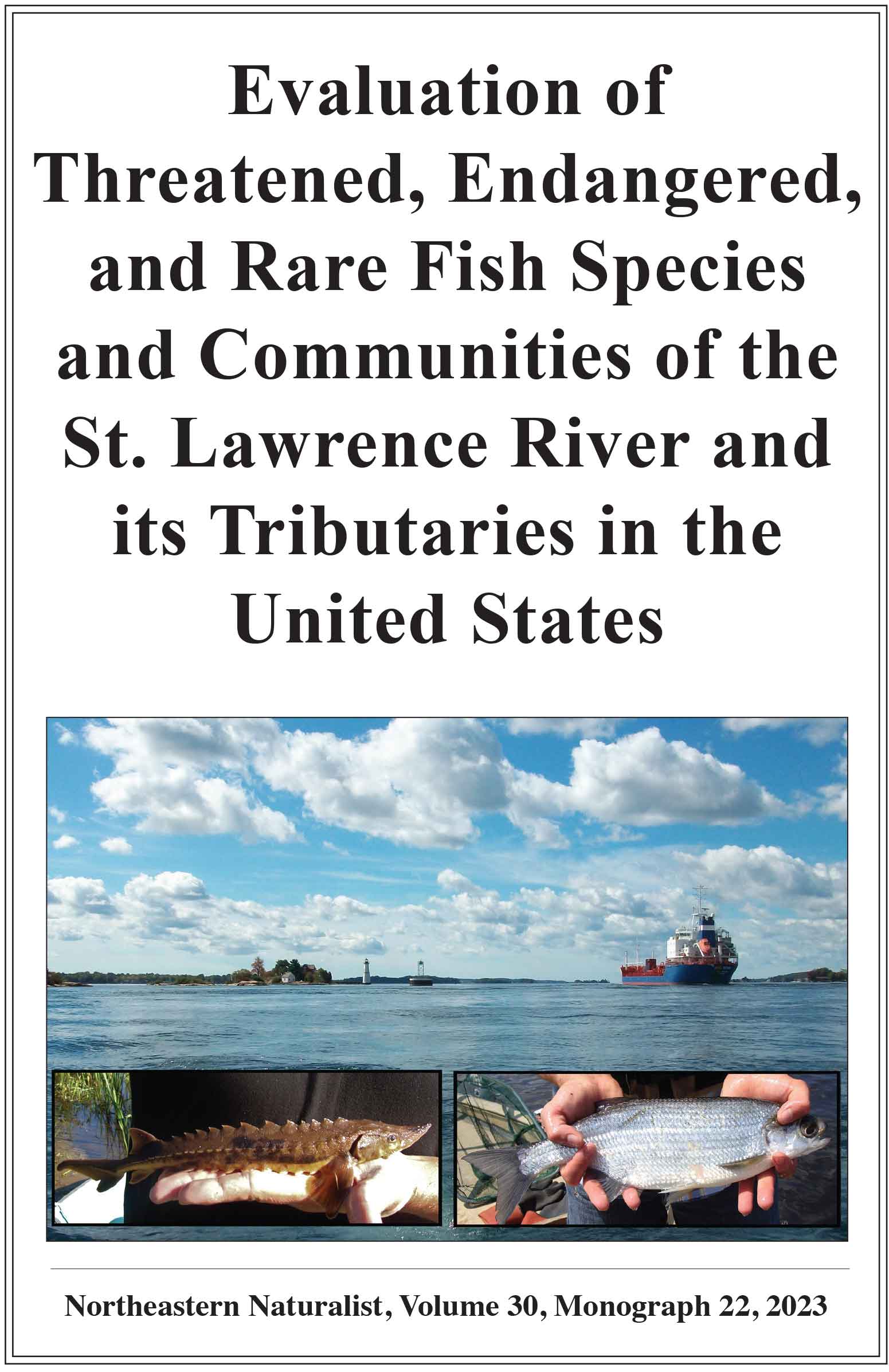Population Characteristics of Striped Bass Killed by Cold
Shock during Winter Shutdown of a Power Plant in Nova
Scotia
Colin F. Buhariwalla, John L. MacMillan, Mathieu J. Gregoire, Michael J. Dadswell, and Michael J.W. Stokesbury
Northeastern Naturalist, Volume 23, Issue 1 (2016): 163–173
Full-text pdf (Accessible only to subscribers. To subscribe click here.)

Access Journal Content
Open access browsing of table of contents and abstract pages. Full text pdfs available for download for subscribers.
Current Issue: Vol. 30 (3)

Check out NENA's latest Monograph:
Monograph 22









Northeastern Naturalist Vol. 23, No. 1
C.F. Buhariwalla, J.L. MacMillan, M.J. Gregoire, M.J. Dadswell, and M.J.W. Stokesbury
2016
163
2016 NORTHEASTERN NATURALIST 23(1):163–173
Population Characteristics of Striped Bass Killed by Cold
Shock during Winter Shutdown of a Power Plant in Nova
Scotia
Colin F. Buhariwalla1,*, John L. MacMillan2, Mathieu J. Gregoire1,
Michael J. Dadswell1, and Michael J.W. Stokesbury1
Abstract - Overwintering Morone saxatilis (Striped Bass) often aggregate in waters heated
by the warm-water discharge of power plants. In these areas, fishes are susceptible to cold
shock during winter disruptions of power generation when the water quickly drops in
temperature. We collected 98 Striped Bass from a suspected cold-shock mortality event at
a power plant in Pictou Harbour, NS, Canada, in January 2013 and herein describe their
size, age structure, and diet. The specimens ranged from 11.8 to 60.2 cm TL and were 1–5
years of age. Fifteen percent of their stomachs contained food, and Striped Bass and Apeltes
quadracus (Fourspine Stickleback) were the only prey species identified. The goal of this
study was to report on the mortality event as a likely recurring source of overwintering
mortality for Striped Bass in the southern Gulf of St. Lawrence, a population designated
by the Committee on the Status of Endangered Wildlife in Canada to be of special concern.
Introduction
Industrial thermal power-generating stations (PGSs) draw cooling water from
adjacent rivers, estuaries, or the ocean, and release it back into the environment as
heated wastewater. Fishes and other aquatic organisms aggregate in the artificial
habitat created by altered current structures and thermal regimes around the cooling-
water intakes and warm-water outflows of these PGSs (Stauffer and Edinger
1980) and are susceptible to mortality through routine station operation. Mortality
occurs through impingement on intake screens, entrainment within the plant (Foster
and Wheaton 1981, Kelso and Milburn 1979, Lewis and Seegert 2000), and thermal
stress associated with temperature variability at the warm-water outflows (Ash et
al. 1974, Donaldson et al. 2008).
The thermal plume created by the heated wastewater disrupts natural seasonal
distribution and behavior of fishes (Stauffer et al. 1976, Williams and Waldman
2010) and affects normal physiological processes (Donaldson et al. 2008, Schreer
and Cooke 2002) as fishes continue to feed and grow during the winter months
(Massengill 1973). Fishes overwintering in warm-water outflow canals are susceptible
to predation and angling pressure (Marcy and Galvin 1973, Williams
and Waldman 2010), however, winter shutdowns of PGSs result in the loss of the
artificial thermal habitat and may cause cold-shock mass-mortality events (Ash
1Biology Department, Acadia University, 33 Westwood Avenue, Wolfville, NS, Canada,
B4P 2R6. 2Nova Scotia Department of Fisheries and Aquaculture, Inland Fisheries
Division, Post Office Box 700, Pictou, NS, Canada, B0K 1H0. *Corresponding author -
ColinBuhariwalla@acadiau.ca.
Manuscript Editor: Jay Stauffer
Northeastern Naturalist
164
C.F. Buhariwalla, J.L. MacMillan, M.J. Gregoire, M.J. Dadswell, and M.J.W. Stokesbury
2016 Vol. 23, No. 1
et al.1974, Coutant 1977). The number of fishes affected by these mass-mortality
events is often difficult to quantify (Labay and Buzan 1999, Ryon et al. 2000), with
impacts on local populations not well known but of concern to fisheries managers
(Douglas et al. 2006).
Morone saxatilis (Walbaum) (Striped Bass) is an economically important anadromous
fish (Richards and Rago 1999) that utilizes habitat influenced by thermal
effluent throughout its range (Marcy and Galvin 1973, Setzler et al. 1980) including
areas in the southern Gulf of St. Lawrence (sGSL), Canada (Rulifson and Dadswell
1995). Disruptions of power generation have been identified as an unpredictable
and recurring source of overwintering mortality for sGSL Striped Bass (Douglas et
al. 2006). Episodic mass-mortality events in the sGSL are of particular importance
for fisheries managers; the stock has been the subject of multiple assessments by
the Committee on the Status of Endangered Wildlife in Canada (COSEWIC) and is
designated as special concern (COSEWIC 2012).
Striped Bass in the sGSL occupy freshwater tributaries, estuaries, and marine
waters from Percé, QC, to western Cape Breton, NS (Rulifson and Dadswell 1995,
Scott and Scott 1988), with the only known spawning population occurring within
the Miramichi River, NB (Robichaud-LeBlanc et al. 1996). After spring spawning,
adults migrate downriver to the Miramichi River estuary, then to coastal waters
and non-natal estuaries throughout the sGSL for summer foraging (Bradford et al.
1998, Douglas et al. 2009). Age-0 Striped Bass exhibit downward estuary dispersal
throughout the summer and are found in adjacent non-natal estuaries by late summer
(Robichaud-LeBlanc et al. 1998, Robinson et al. 2004).
Striped Bass overwinter in estuaries and rivers (Bradford et al. 1998, Douglas et
al. 2003, Hogans and Melvin 1984) throughout the sGSL, resulting in the reduction
of stress from osmoregulatory demand compounded by potentially lethal marine
temperatures (Cook et al. 2006, Hurst and Conover 2002). Overwintering sites
have been documented in many NB rivers and as far east in the sGSL as East River
Pictou, NS (Douglas and Chaput 2011, Rulifson and Dadswell 1995). Within Pictou
Harbour, Striped Bass utilize the warm-water outflow of the Trenton PGS (Fig. 1),
where winter shut downs have been associated with mass-mortality events (Douglas
et al. 2006).
The frequency, age classes, and quantity of fishes affected by these winter mortality
events have not been previously documented (Douglas et al. 2006). In this
study, we collected Striped Bass from a winter mass-mortality event in Pictou Harbour
near the discharge of the Trenton PGS in January 2013. The objectives of this
study were to describe the mortality event and assess the biological characteristics
and diet of specimens collected. This information contributes to an understanding
of the components of overwintering mortality of Striped Bass in the sGSL.
Methods
Study site
The Trenton facility is a 2-turbine (units 5 and 6), coal-fired PGS situated on
Pictou Harbour at the mouth of the East River, NS (Fig. 1). Cooling water is drawn
Northeastern Naturalist Vol. 23, No. 1
C.F. Buhariwalla, J.L. MacMillan, M.J. Gregoire, M.J. Dadswell, and M.J.W. Stokesbury
2016
165
from the estuary of the East River, and heated wastewater from the thermal powergenerating
process is discharged into Pictou Harbour. The maximum daily water
temperature of the warm-water discharge was recorded by power-plant personnel
(C. Beanish, Nova Scotia Department of Environment, North Glasgow, NS, Canada,
pers. comm.); however, ambient temperatures outside the thermal plume were not
available. Winter discharge temperatures during 2014–2015 exceeded 19 ºC above
ambient (mean ±SD = 12.2 ± 4.3 ºC; C.F. Buhariwalda unpubl. data).
Specimen collection
The Nova Scotia Department of Fisheries and Aquaculture (NSDFA), Inland
Fisheries Division was notified of a mortality event in Pictou Harbour on 14
January 2013. We opportunistically collected dead Striped Bass from the shore of
southeast Pictou Harbour adjacent to the mouth of the East River, ~700 m from the
Figure 1. The southern Gulf of St. Lawrence and Pictou Harbour (inset) indicating the
location of the Trenton Power Plant and collection site of Striped Bass mortalities on 14
January 2013.
Northeastern Naturalist
166
C.F. Buhariwalla, J.L. MacMillan, M.J. Gregoire, M.J. Dadswell, and M.J.W. Stokesbury
2016 Vol. 23, No. 1
Trenton PGS (Fig. 1). Striped Bass were typically located under ice in the intertidal
zone and in water depths up to 0.5 m deep; we observed scavengers taking easily
accessible fish. We sent frozen specimens to the Coastal Ecology Lab at Acadia
University. We thawed the fish, assigned a unique ID to each one, and recorded their
weight (W) and total length (TL). We used scales and otoliths to determine fish age
and examined the stomachs to identify and count the contents.
Aging. Prior to examination under a dissecting microscope (40x magnification),
we cleaned scale samples in 70% ethanol and mounted them between microscope
slides and dried the collected otoliths. We counted annuli on both scales and otoliths
to determine age. We collected Striped Bass specimens after 01 January; thus,
we assumed that all scales had formed an annulus at the margin (DeVries and Frie
1996) and we added 1 y to the annulus count on each scale. Specimens that we classified
as age-1 specimens were 2012 age-0 fish that were likely in Pictou Harbour
sometime before winter. C.F. Buhariwalla, M. Gregoire , and M.J. Dadswell aged
scales and otoliths. When there were disagreements in age assignment, the readers
examined the specimens together and reached a consensus; no ages were unresolved.
Weight–length. We determined weight–length relationships using the methods of
Ricker (1975) and the Fisheries Stock Assessment (FSA) package (Ogle 2014), and
evaluated them using the following equation:
log(W) = log(a) + [b × log(TL)]
We performed the geometric mean functional regression (GMR; Ricker 1975)
using the log-transformed length (TL) and weight (W) to determine the slope (b)
and intercept (a) of the regression line. We did not weigh Striped Bass with missing
gut regions (n = 11) resulting from decomposition and/or predation, and we
excluded these specimens from the weight analysis.
We employed R-statistical software (R Core Team 2013) and ggplot2 package
(Wickham 2009) to conduct analyses and create plots of morphometrics and age
data. We determined the uncorrected standard deviation, σ = (Σ[X – μ]2/N)1/2 ,where
σ = the population standard deviation, X = observed value, μ = the population mean,
and N = the number of specimens used in the calculation.
Stomach contents. We dissected stomachs containing food, and identified and
counted prey items based on external morphology and otoliths (Bowen 1996, Campana
2004). We counted partial skeletons and various hard parts (e.g., cleithra) and
classified them as unknown. We followed the methods of Bowen (1996) to calculate
frequency of occurrence and percent composition by number of prey.
Results
Unit 5 was shut down from 04–08 January 2013, and Unit 6 was shut down from
30 December 2012 to 06 January 2013 for unscheduled maintenance at the power
plant. Maximum daily water temperature recorded at the warm-water discharge
before the fish kill was 12.8 ºC on 01 January, but declined to -2.5 ºC during the
cold-shock event after January 04 (Table 1).
Northeastern Naturalist Vol. 23, No. 1
C.F. Buhariwalla, J.L. MacMillan, M.J. Gregoire, M.J. Dadswell, and M.J.W. Stokesbury
2016
167
Sampled mortalities of Striped Bass (n = 98) ranged in size from 11.8 cm to 60.2
cm TL (Table 2), and ages ranged from 1 to 5 years; no individuals of the age-4 year
class were present in the sample. The number of specimens sampled decreased with
increasing age (Table 2). The Striped Bass that we weighed (n = 87) ranged from
0.013 kg to 1.089 kg (Table 2). The weight–length GMR, using units of kg and mm
TL, revealed a strong relationship (R2 = 0.99) with an intercept (a) of -9.02 and a
slope (b) of 3.44 (3.09–3.77 at 95% CL).
We excluded partially decomposed Striped Bass (n = 11) from diet analysis; of
the remaining stomachs, 16% contained food (Table 2). The proportion of stomachs
containing food increased with increased age, ranging from 7% at age-1 to 57% at
age 3. Striped Bass occurred most frequently in stomachs (Table 3) followed by the
only other identifiable prey, Apeltes quadracus (Mitchill) (Fourspine Stickleback).
We found unknown prey (spines and other hard parts) in 21% of the stomachs.
Fourspine Stickleback had the highest percent composition by number, followed by
Table 1. Maximum daily water temperature at cooling-water outflow of Trenton power plant for 14
days in January 2013. * indicates days the generating units were offline.
Temperature (°C)
Date Unit 5 Unit 6
01 January 12.8 12.1*
02 January 12.7 11.7*
03 January 11.8 9.2*
04 January 8.1* 12.4*
05 January -2.4* -0.3*
06 January -2.5* 12.6*
07 January 1.9* 16.6
08 January 3.7* 16.4
09 January 10.0 17.7
10 January 10.9 16.0
11 January 12.4 17.9
12 January 12.5 17.9
13 January 11.8 18.1
14 January 10.2 17.1
Table 2. Summary of age, length, weight, and stomach contents of Striped Bass collected from the
shore of Pictou Harbour on 14 January 2013. Striped Bass exhibiting signs of predation or decomposition
were excluded from weight analysis, and those missing stomachs were excluded from diet
analysis.
Total length (cm) Weight (kg) No. of stomachs
Sample Sample With
Age size Range Mean ± SD size Range Mean ± SD Examined prey
1 63 11.8–19.6 14.9 ± 1.7 57 0.013–0.078 0.027 ± 0.013 59 4
2 25 21.3–37.4 33.4 ± 3.1 23 0.340–0.662 0.448 ± 0.088 23 6
3 9 40.5–46.1 42.8 ± 1.8 7 0.762–1.089 0.929 ± 0.101 7 4
5 1 60.2 - - - - - -
Total 98 11.8–60.2 22.7 ± 11.1 87 0.013-1.089 0.222 ± 0.295 89 14
Northeastern Naturalist
168
C.F. Buhariwalla, J.L. MacMillan, M.J. Gregoire, M.J. Dadswell, and M.J.W. Stokesbury
2016 Vol. 23, No. 1
Striped Bass, and unidentifiable prey items. Fourspine Stickleback occurred in all
but 1 age-1 Striped Bass containing prey, while all but 1 of the age-2 and all age-3
specimens had fed on conspecific age-1 juveniles.
Discussion
Striped Bass mortalities caused by fluctuations in the thermal discharge from
power plants are seldom documented. The January 2013 mortality event in Pictou
Harbour was reported to the NSDFA on 14 January, but likely occurred on 05 January
after daily maximum water temperature in the power-plant discharge dropped
over 12 ºC to sub-zero temperatures. The rapid cooling event likely induced a coldshock
response and eventual mortality (Coutant 1977, Van den Burg et al. 2005)
similar to other unevaluated winter mass-mortality events at this site (Douglas et
al. 2006).
The effect of mass-mortality events on fish populations varies according to local
distribution (Kennedy et al. 2012), species’ natural history (Nagdali and Gupta
2002), and life stage (Ward et al. 2001). Cold-shock mortality events involving
Striped Bass disproportionally affected younger year classes because increased
body size buffers against the effects of cold shock (Donaldson et al. 2008), and
survival during water-temperature fluctuations is dependent on the acclimation
temperature, magnitude, rate of change, and salinities encountered (Beitinger et
al. 2000, Cincotta et al. 1984, Cook et al. 2006). Euryhaline fishes under isotonic
conditions typically exhibit greater upper and lower thermal tolerances than those
in fresh water or more highly saline waters (Stauffer 1986, Stauffer et al. 1984).
Laboratory age-0 Striped Bass acclimated to 5.0 ºC under estuarine conditions
(5–30 ‰) were able to survive a gradual decrease of 2.3 °C·day-1 to temperatures
<0 ºC (Hurst and Conover 2002); however, the lower incipient lethal temperature is
2.4 ºC for juveniles acclimated at 15.0 ºC in fresh water (Cook et al. 2006). These
findings support cold shock as the cause of the mass-mortality event at the Trenton
Power Plant because water temperatures declined >12 ºC to below 0 ºC in less than
24 h. The relative absence of age-3+ and older specimens may be a result of an
ontogenetic shift to cooler thermal preferences (Hartman and Brandt 1995, Nelson
et al. 2010), differential susceptibility to cold-shock, or age-dependent differential
habitat use.
Adult Striped Bass utilize a broad thermal range (6.5 to 28.0 ºC) during summer
foraging, demonstrating an ability to move between greatly different water
Table 3. Composition of stomach contents of Striped Bass containing prey (n = 89) collected on the
shore of Pictou Harbour, 14 January 2013. %N = percent composition by number, n = total number of
prey items counted, %FO = percent frequency of occurrence, and * = not determined.
Total Age-1 Age-2 Age-3
Prey item %N (n) %FO %N (n) %FO %N (n) %FO %N (n) %FO
Apeltes quadracus 46 (13) 29 100 (7) 75 60 (6) 67 0 0
Morone saxatilis 32 (9) 57 0 0 40 (4) 33 46 (5) 100
Unknown 22 (6) 21 * 25 * 17 54 (6) 25
Northeastern Naturalist Vol. 23, No. 1
C.F. Buhariwalla, J.L. MacMillan, M.J. Gregoire, M.J. Dadswell, and M.J.W. Stokesbury
2016
169
temperatures (Nelson et al. 2010). Although some fishes briefly utilize habitats
with potentially lethal temperatures for foraging (Stauffer et al. 1976), thermally
constrained Striped Bass avoid crossing thermoclines to forage on prey 1–2 m
away (Coutant 1985). Large Striped Bass (>100 cm TL) in the Mira River, NS,
move throughout the estuary during winter months and experience a wide temperature
range (1.2–7.5 ºC), while smaller individuals (50–100 cm TL) remain in
intermediate salinity areas (13.0–18.3‰) at stable temperatures (4.0–5.1 ºC) (C.F.
Buhariwalla, unpubl. data). Telemetered Striped Bass (>44 cm TL) around a power
plant on Long Island Sound, NY moved between the warm-water discharge and
ambient waters (2.0–14.0 ºC) throughout the winter (Williams and Waldman 2010).
Older-year classes may have returned to overwintering sites near spawning rivers,
which is common in the sGSL (DFO 2013, Douglas and Chaput 2011) and has been
reported for Striped Bass tagged in Pictou Harbour (>40 cm TL and age-3) and
recaptured in the Miramichi River (Douglas et al. 2006).
Juvenile Striped Bass (age-1 and -2) comprised the majority of samples collected;
however, older Striped Bass (age-3 and -5) were also present. It is likely
that these fish were actively feeding in the warm-water discharge throughout the
winter. All but one of the Striped Bass sampled in Pictou Harbour lacked annuli
at the margins of their scales and otoliths, suggesting continued feeding and
growth, and residency within the warm water. The slope of the weight–length
GMR corroborated that active feeding occurred throughout the winter, with weight
increasing faster than length. Hurst and Conover (1998) reported minimum temperatures
required for age-0 Striped Bass to maintain growth in length and weight
at 10 ºC and 5 ºC, respectively. The continued feeding and growth of the Striped
Bass found in Pictou Harbour indicates that they inhabited the warm-water outflow
of the power plant prior to their death.
Although stomach contents indicated that our Striped Bass specimens were
feeding in the warm water discharge, we identified only 2 prey species. Juvenile
Striped Bass was the most common prey found in the stomachs of age-2 and
older specimens collected from the fish kill, while age-1 fish fed predominantly on
Fourspine Stickleback. These findings differ from other studies where low rates
of cannibalism (0.33–4%) were reported for wild Striped Bass (Manooch 1973,
Shapovalov 1936, Smith and Reay 1991) and could be reflective of increased vulnerability
of predation resulting from the effects of cold shock (Donaldson et al.
2008). Invertebrates are generally the dominant prey of age-0 and age-1 Striped
Bass from North Carolina to sGSL, and although piscivory increases with age,
invertebrates also play an important role in the diets of older juveniles and adults
(Walter et al. 2003). Crangon crangon L. (Sand Shrimp) and mysids were the dominant
prey of large (>12 cm TL) age-0 Striped Bass in Minas Basin, Bay of Fundy,
and in the Miramichi estuary, with fishes making only a minor contribution to their
overall diet (Robichaud-LeBlanc et al. 1997, Rulifson and McKenna 1987). We
found no evidence of invertebrates in the stomachs of the Pictou Harbour mortalities.
Occurrence of empty stomachs among overwintering Striped Bass is common
(Hurst and Conover 2001, Williams and Waldman 2010); however, limited prey
Northeastern Naturalist
170
C.F. Buhariwalla, J.L. MacMillan, M.J. Gregoire, M.J. Dadswell, and M.J.W. Stokesbury
2016 Vol. 23, No. 1
diversity and an ontogenetic increase in the proportion of specimens exhibiting cannibalism
suggests there was a lack of prey available in the discharge plume prior to
the mortality event. This suggestion was corroborated by field observations during
the winter of 2014–2015 (C.F. Buhariwalla, pers. observ.).
Although fish-kill mortality events are a recurring problem (Douglas et al. 2006,
La and Cooke 2011), our study contains the first description of Striped Bass mortality
from a suspected cold-shock event. The true extent of the kill is unknown
because time since the event and extent of scavenging may be major factors in the
number and size of samples recovered (Labay and Buzan 1999, Ryon et al. 2000);
however, the 2013 event in Trenton likely had a negligible impact on the sGSL
population because spawner abundance was at a record high in 2011 (203,000
spawners; DFO 2013). On the other hand, during years of low Striped Bass abundance
(e.g., 3,000–5,000 spawners in 1996–99; COSEWIC 2012), fish-kill events
could impact this COSEWIC-assessed population, and we recommend evaluation
of future events.
Acknowledgments
We would like to thank C. Beanish for contacting NSDFA concerning the fish kill. R.
Theriault and J. Beardsall assisted with sample preparation, and A. Redden and J. Broome
assisted with age determination. We would also like to thank the anonymous reviewers
who provided valuable suggestions for improving this manuscript. M.J.W. Stokesbury is
supported by the Canada Research Chairs program and by the National Science and Engineering
Research Council of Canada.
Literature Cited
Ash, G.R., N.R. Chymko, and D.N. Gallup. 1974. Fish kill due to “cold shock” in Lake
Wabamun, Alberta. Journal of the Fisheries Research Board of Canada 31:1 822–1824.
Beitinger, T.L., W.A. Bennett, and R.W. McCauley. 2000. Temperature tolerances of North
American freshwater fishes exposed to dynamic changes in temperature. Environmental
Biology of Fishes 58:237–27.
Bowen, S.H. 1996. Quantitative description of the diet. Pp. 513–532, In B.R. Murphy
and D.W. Willis (Eds.). Fisheries Techniques, 2nd Edition. American Fisheries Society
Bethesda, MD. 732 pp.
Bradford, R.G., E. Tremblay, and G.J. Chaput. 1998. Winter distribution of Striped Bass
(Morone saxatilis) and associated environmental conditions in Kouchibouguac National
Park during 1996–1997. Ecosystem Monitoring and Data Report 0003. Parks Canada,
Ottawa, ON, Canada. 60 pp.
Campana, S.E. 2004. Photographic Atlas of Fish Otoliths of the Northwest Atlantic Ocean.
NRC Research Press, Ottawa, ON, Canada. 284 pp.
Cincotta, D.A., J.R. Stauffer Jr., and C.H. Hocutt. 1984. The effects of rapid temperature
decreases on five freshwater fish species. Archiv Für Hydrobiologie 99:529–536.
Committee on the Status of Endangered Wildlife in Canada (COSEWIC). 2012. COSEWIC
assessment and status report on the Striped Bass, Morone saxatilis, in Canada. Ottawa,
ON. 97 pp.
Cook, A.M., J. Duston, and R.G. Bradford. 2006. Thermal tolerance of a northern population
of Striped Bass, Morone saxatilis. Journal of Fish Biology 69:1482–1490.
Northeastern Naturalist Vol. 23, No. 1
C.F. Buhariwalla, J.L. MacMillan, M.J. Gregoire, M.J. Dadswell, and M.J.W. Stokesbury
2016
171
Coutant, C.C. 1977. Cold shock to aquatic organisms: Guidance for power-plant siting,
design, and operation. Nuclear Safety 18:329–342.
Coutant, C.C. 1985. Striped Bass, temperature, and dissolved oxygen: A speculative hypothesis
for environmental risk. Transactions of the American Fisheries Society 114:31–61.
Department of Fisheries and Oceans (DFO). 2013. Update to 2012 on spawner abundance
and biological characteristics for Striped Bass (Mororne saxatilis) in the southern Gulf
of St. Lawrence. Canadian Science Advisory Secretariat Scientific Response 2013/010.
Fisheries and Oceans Canada, Ottawa, ON, Canada. 18 pp.
DeVries, D.R., and R.V. Frie. 1996. Determination of age and growth. Pp. 483–512, In B.R.
Murphy, and D.W. Willis (Eds.). Fisheries Techniques, 2nd Edition. American Fisheries
Society, Bethesda, MD. 732 pp.
Donaldson, M.R., S.J. Cooke, D.A. Patterson, and J.S. MacDonald. 2008. Review paper:
Cold shock and fish. Journal of Fish Biology 73:1491–1530.
Douglas, S.G., and G. Chaput. 2011. Information on the Striped Bass (Morone saxatilis)
population of the southern Gulf of St. Lawrence relevant to the development of a 2nd
COSEWIC status report for the species. Canadian Scientific Advisory Secretariat Research
Document 2011/098. Fisheries and Oceans Canada, Ottawa, ON, Canada.
Douglas, S.G., R.G. Bradford, and G. Chaput. 2003. Assessment of Striped Bass (Morone
Saxatilis) in the Maritime Provinces in the context of species at risk. Canadian Scientific
Advisory Secretariat Research Document 2003/008. Fisheries and Oceans Canada, Ottawa,
ON, Canada.
Douglas, S.G., G. Chaput, and D. Caissie. 2006. Assessment of status and recovery potential
for Striped Bass (Morone saxatilis) in the southern Gulf of St. Lawrence. Canadian Science
Advisory Secretariat Research Document 2006/41, Ottawa, Canada.
Douglas, S.G., G. Chaput, J. Hayward, and J. Sheasgreen, 2009. Prespawning, spawning,
and postspawning behavior of Striped Bass in the Miramichi River. Transactions of the
American Fisheries Society 138:121–134.
Foster J.R., and T.J. Wheaton. 1981. Losses of juvenile and adult fishes at the Naticoke
thermal generating station due to entrapment, impingement, and entrainment. Journal of
Great Lakes Research 7:162–170.
Hartman, K.J., and S.B. Brandt. 1995. Comparative energetics and the development of bioenergetics
models for sympatric estuarine piscivores. Canadian Journal of Fisheries and
Aquatic Sciences 52:1647–1666.
Hogans, W.E., and G. Melvin. 1984. Kouchibouguac National Park Striped Bass Morone
saxatilis (Walbaum) fishery survey. Aquatic Industries Ltd., St. Andrews, NB, Canada.
Hurst, T.P., and D.O. Conover. 1998. Winter mortality of young-of-the-year Hudson River
Striped Bass (Morone saxatilis): Size-dependent patterns and effects on recruitment.
Canadian Journal of Fisheries and Aquatic Sciences 55:1122–1130.
Hurst, T.P., and D.O. Conover. 2001. Diet and consumption rates of overwintering YOY
Striped Bass, Morone saxatilis, in the Hudson River. Fishery Bulletin 99:545–553.
Hurst, T.P., and D.O. Conover. 2002. Effects of temperature and salinity on survival of
young-of-the-year Hudson River Striped Bass (Morone saxatilis): Implications for
optimal overwintering habitats. Canadian Journal of Fisheries and Aquatic Sciences
59:787–795.
Kelso J.R.M., and G.S. Milburn. 1979. Entrainment and impingement of fish by power
plants in the Great Lakes that use the once-through cooling process. Journal of Great
Lakes Research 5:182–194.
Kennedy, R.J., R. Russel, and J. Hayes. 2012. Recovery patterns of salmonid populations
following a fish-kill event on the River Blackwater, Northern Ireland. Fisheries Management
and Ecology 19:214–223.
Northeastern Naturalist
172
C.F. Buhariwalla, J.L. MacMillan, M.J. Gregoire, M.J. Dadswell, and M.J.W. Stokesbury
2016 Vol. 23, No. 1
La, V.T., and S.J. Cooke. 2011. Advancing the science and practice of fish-kill investigations.
Reviews in Fisheries Science 19:21–33.
Labay, A.A., and D. Buzan. 1999. A comparison of fish-kill counting procedures on a small,
narrow stream. North American Journal of Fisheries Management 19:209–214.
Lewis, R.B., and G. Seegert. 2000. Entrainment and impingement studies at two power
plants on the Wabash River in Indiana. Environmental Science and Policy 3:303–312.
Manooch, C.S. 1973. Food habits of yearling and adult Striped Bass, Morone saxatilis (Walbaum),
from Albemarle Sound, North Carolina. Chesapeake Science 14:73–86.
Marcy, B.C., Jr., and R.C. Galvin. 1973. Winter–spring sport fishery in the heated discharge
of a nuclear power plant. Journal of Fish Biology 5:541–547.
Massengill, R.R. 1973. Change in feeding and body condition in Brown Bullheads overwintering
in the heated effluent of a power plant. Chesapeake Scien ce 14:138–141.
Nagdali, S.S., and P.K. Gupta. 2002. Impact of mass mortality of Mosquitofish, Gambusia
affinison, on the ecology of a fresh water eutrophic lake (Lake Naini Tal, India). Hydrobiolgia
468:45–51.
Nelson, G.A., M.P. Armstrong, J. Stritzel-Thomson, and K.D. Friedland, 2010. Thermal
habitat of Striped Bass (Morone saxatilis) in coastal waters of northern Massachusetts,
USA, during summer. Fisheries Oceanography 19:370–381.
Ogle, D.H. 2014. FSA: Fisheries stock assessment. R package version 0.4.3. Available online
at http://www.derelogle.com/fishR/packages. Accessed 15 February 2015.
R Core Team. 2013. R: A language and environment for statistical computing. R Foundation
for Statistical Computing. Vienna, Austria. Nline at http:/www.R-project.org/. Accessed
9 February 2015.
Richards, R.A., and P.J. Rago. 1999. A case history of effective fishery management: Chesapeake
Bay Striped Bass. North American Journal of Fisheries Management 19:356–375.
Ricker, W.E. 1975. Computation and interpretation of biological statistics of fish populations.
Bulletin 191 of the Fisheries Research Board of Canada, Ottawa, ON, Canada.
Robichaud-LeBlanc, K.A., S.C. Courtenay, and A. Locke. 1996. Spawning and early lifehistory
of a northern population of Striped Bass (Morone saxatilis) in the Miramichi
River estuary, Gulf of St. Lawrence. Canadian Journal of Zoology 74:1645–1655.
Robichaud-LeBlanc, K.A., S.C. Courtenay, and M.J. Hanson. 1997. Ontogenetic diet shifts
in age-0 Striped Bass, Morone saxatilis, from the Miramichi River estuary, Gulf of St.
Lawrence. Canadian Journal of Zoology 75:1300–1309.
Robichaud-LeBlanc, K.A., S.C. Courtenay, and T.J. Benfey. 1998. Distribution and growth
of young-of-the-year Striped Bass in the Miramichi River Estuary, Gulf of St. Lawrence.
Transactions of the American Fisheries Society 127:56–69.
Robinson, M., S. Courtenay, T. Benfey, L. Maceda, and I. Wirgin. 2004. Origin and movements
of young-of-the-year Striped Bass in the southern Gulf of St. Lawrence, New
Brunswick. Transactions of the American Fisheries Society 133:412–426.
Rulifson, R.A., and M.J. Dadswell. 1995. Life-history and population characteristics
of Striped Bass in Atlantic Canada. Transactions of the American Fisheries Society
124:477–507.
Rulifson, R.A., and S.A. McKenna. 1987. Food of Striped Bass in the upper Bay of Fundy,
Canada. Transactions of the American Fisheries Society 116:119–122.
Ryon, M.G., J.J. Beauchamp, W.K. Roy, E. Schilling, B.A. Carrico, and R.L. Hinzman.
2000. Stream dispersal of dead fish and survey effectiveness in a simulated fish kill.
Transactions of the American Fisheries Society 129:89–100.
Northeastern Naturalist Vol. 23, No. 1
C.F. Buhariwalla, J.L. MacMillan, M.J. Gregoire, M.J. Dadswell, and M.J.W. Stokesbury
2016
173
Schreer, J.F., and S.J. Cooke. 2002. Behavioral and physiological responses of Smallmouth
Bass to a dynamic thermal environment. American Fisheries Society Symposium
32:191–203.
Scott, W.B., and M.G. Scott. 1988. Atlantic Fishes of Canada. University of Toronto Press,
Toronto, ON, Canada. 731 pp.
Setzler, E.M., W. Boynton, K. Wood, H. Zion, L. Lubbers, N. Mountford, P. Frere, L.
Tucker, and J. Mihursky. 1980. Synopsis of biological data on Striped Bass, Morone
saxatilis (Walbaum). National Oceanic and Atmopsheric Administration Technical Report,
National Marine Fisheries Service Circular 433. Silver Spring, MD. 77 pp.
Shapovalov, L. 1936. Food of the Striped Bass. California Fish and Game 22:261–271.
Smith, C., and P. Reay. 1991. Cannibalism in teleost fish. Reviews in Fish Biology and
Fisheries 1:41–64.
Stauffer, J.R., Jr. 1986. Effects of salinity on preferred and lethal temperatures of the
Mozambique Tilapia, Oreochromis mossambicus (Peters). Water Resources Bulletin
22(2):205–208.
Stauffer, J.R., Jr., and J.E. Edinger.1980. Power-plant design and fish-aggregation phenomena.
Pp. 9–28, In C.H. Hocutt, J.R. Stauffer Jr., J.E. Edinger, L.W. Hall, and R.P.
Morgan (Eds.). Power Plants: Effects on Fish and Shellfish Behaviour. Academic Press,
New York, NY. 346 pp.
Stauffer, J.R., Jr., K.L. Dickson, J. Cairns Jr., and D.S. Cherry. 1976. The potential and realized
influences of temperature on the distribution of fishes in the New River, Glen Lyn,
Virginia. Wildlife Monographs 50:1–40.
Stauffer, J.R., Jr., D.K. Vann, and C.H. Hocutt. 1984. Effects of salinity on preferred and
lethal temperatures of the Blackchin Tilapia, Sarotherodon melanotheron. Water Resources
Bulletin 20(5):771–775.
Van den Burg, E.H., R.R. Peeters, M. Verhoye, J. Meek, G. Flik, and A.Van der Linden.
2005. Brain responses to ambient temperature fluctuations in fish: Reduction of blood
volume and initiation of a whole-body stress response. Journal of Neurophysiology
93:2849–2855.
Walter, J.F. III, A.S. Overton, K.H. Ferry, and M.E. Mather. 2003. Atlantic coast feedinghabits
of Striped Bass: A synthesis supporting a coast-wide understanding of trophic
biology. Fisheries Management and Ecology 10:349–360.
Ward, T.M., F. Hoedt, L. McLeay, W.F. Dimmlich, M. Kinloch, G. Jackson, R. McGarvey,
P.J. Rogers, and K. Jones. 2001. Effects of the 1995 and 1998 mass-mortality events on
the spawning biomass of Sardine, Sardinops sagax, in South Australian waters. ICES
Journal of Marine Science 58:865–875.
Wickham, H. 2009. ggplot2: Elegant Graphics for Data Analysis. Springer, New York, NY.
224 pp.
Williams, K., and J. Waldman. 2010. Aspects of the wintering biology of Striped Bass at a
power-plant discharge. Northeastern Naturalist 17:373–386.












